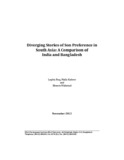Diverging stories of son preference in South Asia: a comparison of India and Bangladesh
Abstract
In Bangladesh, overall sex ratio has declined from 109.6 (males/females) in the
1950s to 100.3 in 2011. Unlike countries with female deficits, the improvement in
sex ratio has extended to the under‐5 age group. This has happened in a context
where per‐capita income has grown modestly but poverty continues to be
widespread. Thus the story of “missing women” is evolving differently in
Bangladesh than from India where decline in overall sex ratios has been
accompanied by worsening of child sex ratios. In this paper we explore the
hypothesis that improvement in child sex ratios in Bangladesh is due to a shift in
parental preferences about sex composition of families in a society undergoing
rapid socio‐economic change. Using a combination of quantitative and qualitative
data, we find that parents are less likely to discriminate between sons and
daughters than in the past with respect to survival and investments in human
capital. These changes indicate a weakening of patriarchal structures and cultural
norms around fertility intentions and sex composition of families. In comparison
to India, it is speculated that the diverging story of sex preference in Bangladesh
could be related to the timing of introduction of sex selection technology and the
role of the state and civil society in the two contexts.

